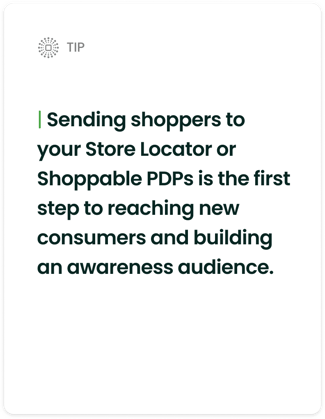4. Pixels & performance marketing ![]() 5. Awareness
5. Awareness ![]() 6. Trial
6. Trial
Driving brand awareness
So far you’ve learned about shoppability for CPG brands, using insights to understand shopper behavior, and leveraging pixels for audience building and marketing. Missed something? Revisit here: Shoppability / insights / marketing.
This section explores the essential first stage of the digital share-of-wallet funnel: Creating consumer awareness.

| GENERATING CPG AWARENESS & DISCOVERY
The awareness stage is when a brand works to get noticed by consumers. It's the first step in the discovery process. For CPG brands looking to generate greater awareness—particularly around retail partnerships or retail ecommerce experiences—focus your marketing efforts on:
-
Introducing your products to new audiences.
-
Highlighting the unique value of your products to both new and existing audiences.
-
Educating audiences on your products, especially where and how to buy them.
Using organic and paid marketing strategies helps drive traffic to your website, giving customers more ways to engage with your brand. As users interact, pixel events are relayed to your ad platforms (covered in the previous section), allowing you to develop an audience at the awareness stage of the funnel. Your awareness audience reveals future opportunities for retargeting and crafting more personalized marketing campaigns.
Once you successfully establish awareness, shoppers move into the next stage of the funnel, turning that initial exposure to your brand into product trials. More on that in the next section.
| STRATEGICALLY BUILDING AN AWARENESS AUDIENCE
Building custom audiences with shoppable tools helps your brand engage effectively, sell smoothly, and foster lasting support. Gain benefits like:
- Targeted communication
Creating audiences allows you to tailor your messaging to align with the specific needs, preferences, locations, and behaviors of your shoppers. Feature products based on your shoppers’ locations with dynamic shoppability.
As you progress beyond awareness and into deeper stages of the funnel, actionable insights become invaluable. Leveraging these insights early, along with location-specific inventory, allows for stronger connections and better results down the funnel. - New product or new retail partner launches
Now, you’re set up for more impactful promotions. For instance, online visitors who’ve used your Store Locator can be identified as a retailer-loyal group, perfect for promoting new partnerships. Similarly, launching a new product to top-of-funnel audiences already generally familiar with your brand can drive higher engagement and improve campaign success.
See how our partner, Saucy Spoon, used ecommerce to boost awareness for their new product launch. - Customer retention
Re-engaging with your aware audience helps maintain your brand connection. Retargeting through email or SMS keeps you top of mind and encourages potential customers to move further down the funnel toward purchase. - Increased purchase intent
A well-defined audience is more likely to convert. Focusing your marketing efforts on individuals who have already shown interest ensures a targeted approach that is more likely to resonate and deliver results.
Once you build an initial audience around awareness, you unlock the true retail ecommerce opportunities.



